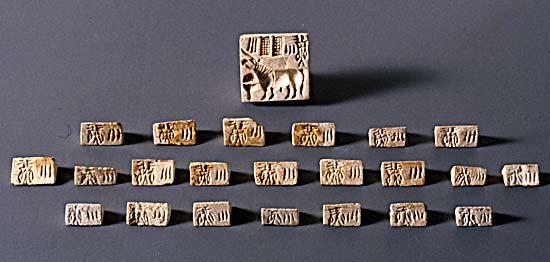An additional six copies of these tablets, again all with the same inscriptions, were found elsewhere in the debris outside of perimeter wall [250] including two near the group of 16 and two in debris between the perimeter and curtain walls. Here all 22 tablets are displayed together with a unicorn intaglio seal from the Period 3B street inside the perimeter wall, which has two of the same signs as those found on the tablets. (See also 55, 56, 57, 58, 59, 60).Quoting from R.H. Meadow and J.M. Kenoyer's article in South Asian Archaeology 1997 (Rome, 2001): "It is tempting to think that the evident loss of utility and subsequent discard of the tablets is related to the “death” of the seal. Seals are almost always found in trash or street deposits (and never yet in a grave) indicating that they were either lost or intentionally discarded, the latter seeming the more likely in most instances. The end of the utility of a seal must relate to some life event of its owner, whether change of status, or death, or the passing of an amount of time during which the seal was considered current. A related consideration is that apparently neither seals nor tablets could be used by just anyone or for any length of time because otherwise they would not have fallen out of circulation. Thus the use of seals -- and of tablets -- was possible only if they were known to be current. Once they were no longer current, they were discarded. This would help explain why a group of 16 (or 18) tablets with the same inscriptions, kept together perhaps in a cloth or leather pouch, could have been deposited with other trash outside of the perimeter wall of Mound E."

